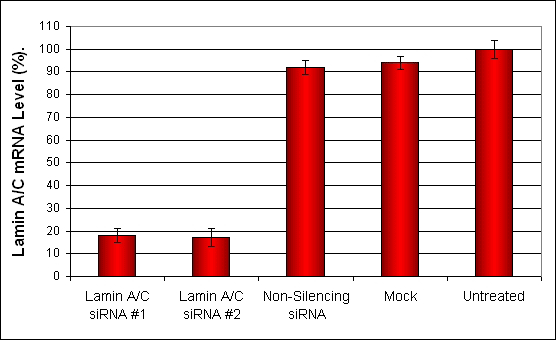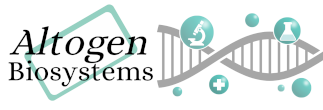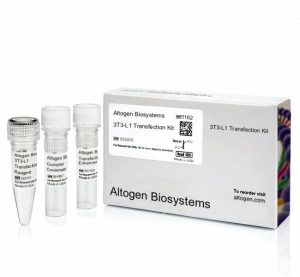Description
Purchase Orders: Click “Add to Cart” button to order, then email PO to orders@altogen.com.
Product Availability: In Stock.
Transfection Reagent for 3T3 L1 Cells (Embryonic Fibroblast Cells, CL-173)
- Proprietary cationic lipids formulation
- Effective and robust intracellular delivery
- Kit includes Transfection Enhancer reagent
- Produces consistent results, lot-to-lot, plate-to-plate, and well-to-well
- A proven reagent for establishing stable cell lines
- Optimized transfection protocols are adapted for use with both standard & reverse transfection methods
- Download in vitro 3T3-L1 transfection protocol: [PDF]
- Download 3T3-L1 CRISPR/Cas9 transfection protocol: [PDF]
- Download PowerPoint presentation for 3T3-L1 cells transfection kit: [PPT]
- UPC/GTIN/EAN: 860002089719
-
Brand: ALTOGEN®, developed and manufactured by Altogen Biosystems
Transfection Efficiency:
Reagent exhibits at least 80% transfection efficiency of siRNA delivery. Transfection efficiency was determined by real-time RT-PCR.
Transfection Protocol and SDS:
Download Altogen Biosystems 3T3 Transfection Protocol: [PDF]
Download SDS: [PDF]
Product Description:
Optimized transfection kit for high transfection efficiency of 3T3-L1 cell line originating from mouse embryonic fibroblasts, these cells have the remarkable ability to differentiate into adipocytes under appropriate culture conditions.Used in biological and medical research, particularly in the study of adipocyte differentiation, metabolism, and obesity-related diseases.
3T3 Cell Line:
The 3T3-L1 cell line was established in 1974 from a Swiss albino mouse (Mus musculus) embryo. This cell line exhibits fibroblast morphology and is very similar to the 3T3 cell line, from which it is derived. These cells do not carry ectromelia virus (mousepox). 3T3-L1 could be useful for studying fibroblast cells, or mammalian embryonic tissue. This cell line has been known to double nearly every 14 hours. 3T3-L1 cells are sensitive to lipolytic and lipogenic hormones and drugs such as epinephrine, isoproterenol, and insulin. Progressing from a rapidly dividing to a confluent and contact inhibited state, 3T3-L1 cell line undergoes a pre-adipose to adipose-like conversion. 3T3-L1 is an embryonic mouse fibroblast cell line widely used in the study of adipose tissue as its cells can differentiate into adipocytes under proper conditions. Altogen Biosystems provides lipid-based transfection kits for the 3T3-L1 cell line.
3T3L1 is a mouse embryonic fibroblast cell line that is commonly used as a model for studying adipocyte differentiation and metabolism. These cells were originally isolated in 1962 from Swiss mouse embryo tissue and have since been widely used in research. 3T3L1 cells can be induced to differentiate into adipocytes, which makes them useful for investigating the molecular mechanisms involved in adipogenesis. Adipogenesis is the process by which preadipocytes differentiate into mature adipocytes, which are the primary cell type responsible for storing and releasing energy in the form of triglycerides. During adipocyte differentiation, 3T3L1 cells undergo a series of morphological and biochemical changes, including the upregulation of adipogenic transcription factors such as PPARγ and C/EBPα, the accumulation of lipid droplets, and the expression of adipocyte-specific genes such as adiponectin and leptin. 3T3L1 cells have been used in a wide range of research applications, including the investigation of the molecular mechanisms underlying obesity and metabolic disorders, the identification of novel anti-obesity agents, and the development of adipose tissue engineering strategies. Additionally, 3T3L1 cells have been used to study the effects of various environmental factors, such as diet and exercise, on adipocyte metabolism and function.
Data:

Figure 1. siRNAs targeting Lamin A/C mRNA or non-silencing control siRNA were transfected into 3T3L1 cells following the recommended protocol. At 48 hours post-transfection the cells were analyzed by qRT-PCR for Lamin A/C gene expression levels. 18S rRNA levels were used to normalize the Lamin A/C data. Values are normalized to untreated sample. Data are means ± SD (n=4).

Figure 2. Protein expression of Lamin A/C in 3T3-L1 cells. DNA plasmid expressing Lamin A/C or siRNA targeting Lamin A/C were transfected into 3T3-L1 cells following Altogen Biosystems transfection protocol. At 72 hours post-transfection the cells were analyzed by Western Blot for protein expression levels (normalized by total protein, 10 µg of total protein loaded per each well). Untreated cells used as a negative control.
Selected in vivo transfection product citations (ALTOGEN® IN VIVO Transfection Kits used in the following publications):
- Nature. 2008 454(7203):523-7. Innate immunity induced by composition-dependent RIG-I …Saito et al [PDF]
- Am J Pathology. 2010 177(4):1870-80. Role of ocular complement factor H in a murine model … Lyzogubov et al [PDF]
- Nature Biotechnology. 2011 29(4):341-5. Delivery of siRNA to the mouse brain by … Alvarez-Erviti et al [PDF]
- Cancer Research. 2011 71(15):5144-53. Inhibition of miR-193a expression by… Iliopoulos et al [PDF]
- RNA. 2010 16(11):2108-19. RNase L releases a small RNA from HCV RNA that refolds … Malathi et al [PDF]
- Diabetologia. 2012 55(7):2069-79. The p47phox- and NADPH oxidase organiser 1 … Youn et al [PDF]
- British Journal of Cancer. 2012 107(3):516-26. TIGAR induces p53-mediated cell-cycle … Madan et al [PDF]
- Hypertension. 2014 63(2):353-61. Tissue transglutaminase contributes to … Liu et al [PDF]
- Circulation Research. 2010 15;107(8). Kruppel-like factor-4 transcriptionally regulates … Cowan et al [PDF]
- Hypertension. 2012 59(1):158-66. Role of uncoupled endothelial nitric oxide synthase … Gao et al [PDF]
- Jounal of Biological Chemistry. 2012 287(4):2907. Chaperoning of mutant p53 protein … Gogna et al [PDF]
- Mol Cell Biol. 2013 33(7). SCO2 induces p53-mediated apoptosis by Thr845 phosphorylation … Madan et al [PDF]
- Hypertension. 2015 65(2):430-9. Neurokinin 3 receptor and phosphocholine transferase… Parchim et al [PDF]
Altogen Biosystems manufacturers over 100 pre-optimized in vitro transfection kits for cancer cell lines and primary cells, elecroporation products, and tissue-targeted in vivo delivery reagents for life science research. Advanced formulation of reagents and optimized transfection protocols provide efficient intracellular delivery of protein, DNA, mRNA, shRNA and siRNA molecules. Read more about transfection technology at Altogen’s Transfection Resource. Altogen Labs provides GLP-compliant contract research studies for preclinical research, IND applications, and drug development. Biology CRO services include: xenograft models (90+), development of stable cell lines, ELISA assay development, cell-based and tissue targeted RNAi studies, safety pharm/tox assays, and other preclinical studies (visit AltogenLabs.com).
Volume Options:
- 0.5 ml (Catalog #1161)
- 1.5 ml (Catalog #1162)
- 1.5 ml CRISPR (Catalog #2207)
- 8.0 ml (Catalog #7016)
Purchase Orders: Click “Add to Cart” button to order, then email PO to orders@altogen.com.
Product Availability: In Stock.






